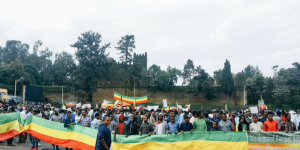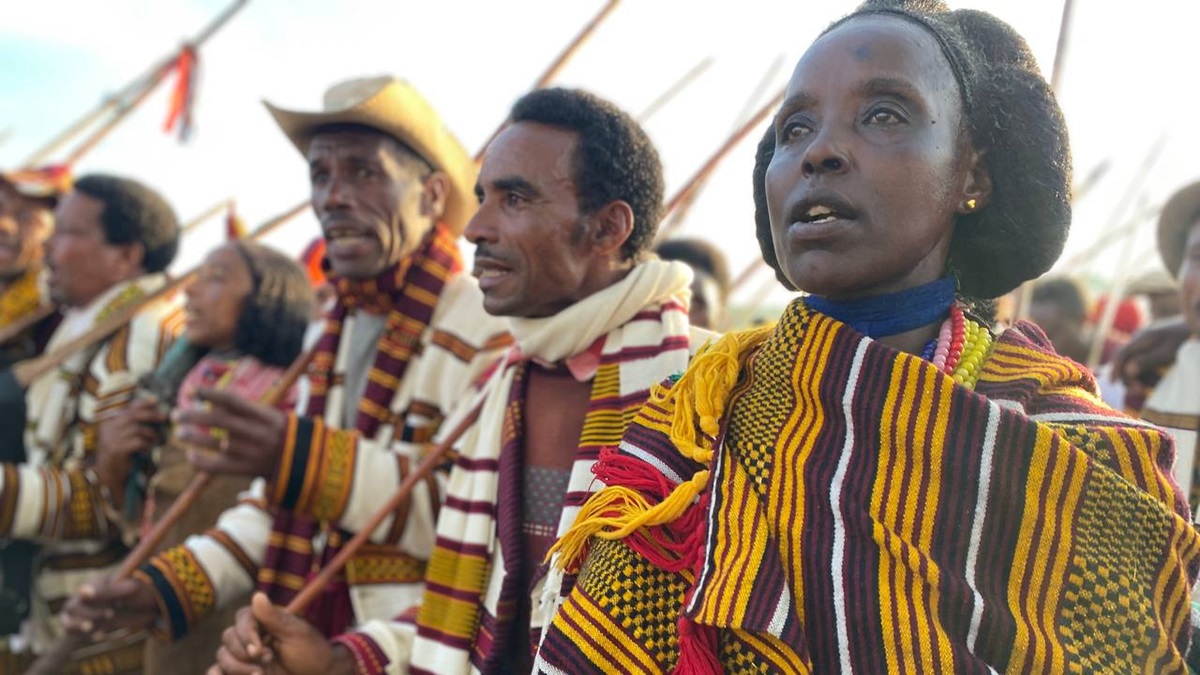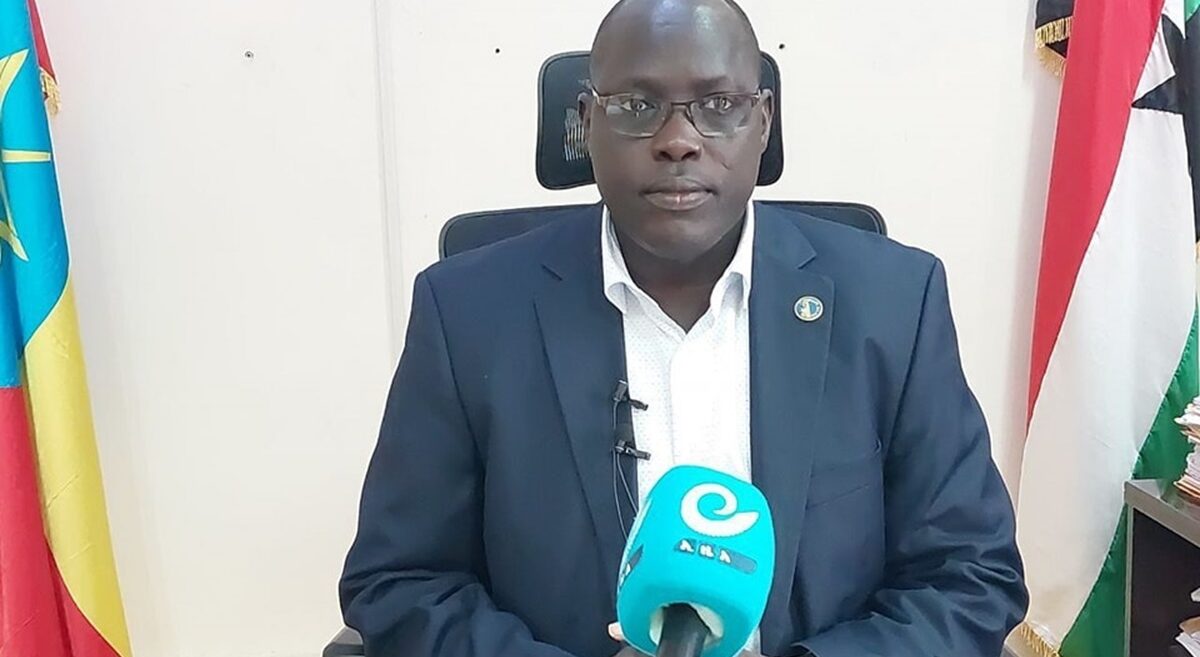Commentary:The Birth of Amhara Nationalism: Causes, Aspirations, and Potential Impacts
Protesters during the summer 2016 AmharaProtests in Gonder city. Photo: Social media
Amanuel Tesfaye, For Addis Standard
Addis Abeba, May 04/2018 – In a speech given at the discussion forum organized by the Amhara Regional State for academics and few selected business people in the beautiful city of Bahir Dar, newly appointed Prime Minister Abiy Ahmed said that he was worried by the growing Amhara nationalism, calling for scholars to study, understand and suggest ways forward to the government. While a lot of commentary has been written on the protests and instability of the country over the past three years, little has been said about the rising potency of Amhara nationalism and its implications. This article is an attempt to provide a cursory look at the trajectory of the movement by identifying its underlying causes, demands, and potential impacts.
The causes
While it is difficult to come up with an exhaustive list of factors that precipitated Amhara nationalism, few stand out. It is possible to argue that the first principal factor behind the rise of Amhara nationalism has been the very narrative of Ethiopia’s current federalism, which is based on ethnic arrangements. Most of the ethno-nationalist movements that overthrew the military regime, Derg, held an implicit and/or explicit assumption that the main motivating factor behind their struggle was Amhara oppression. The Tigrayan Peoples Liberation Front (TPLF), for instance, believed that the root cause of oppression and injustice in Ethiopia lies in “Amhara’s chauvinistic great nation” mentality, thus making its struggle a de facto attempt to eliminate this mentality within the Amhara. The first ever manifesto of the party blatantly describes its struggle as “anti-Amhara national oppression”[i], clearly identifying the Amhara as the principal enemy along with imperialism. The Oromo Liberation Movement (OLF), perceiving Ethiopia to be characterized by “Amhara dominance”, oriented its fight towards “liberating” the Oromo by overthrowing this oppression. As Mohammed Hassan succinctly put it, “Oromo nationalism emerged partly out of the struggle against Amhara domination”[ii]. With the coming to power of the ruling Ethiopian People’s Revolutionary Democratic Front (EPRDF) spearheaded by the powerful TPLF, this narrative became the hegemonic view of Ethiopian historiography and political discourse. The restructuring of the Ethiopian state along ethnic federal lines with this hegemonic thought in mind meant the narrative was now given an institutional expression. Thus, by design, the federation aimed to ‘liberate’ the multitude of ethnicities in order to enable ‘self-determination’, while simultaneously containing the Amhara so that other groups can continue to exercise their ‘self-rule’. A recent article by Biniam Menberework for Addisstandard insightfully argues that the logical role of the regional party (ANDM) became ‘disciplining’ the Amhara instead of representing them. Derogatory terms like ‘Chauvinist’, ‘Oppressor’ ‘Neftegna (gunslinger)’, ‘Yekedmo sre’at nafaqi’ (one who pines for the old order), became the favorite expressions used by EPRDF officials (including those from the ANDM) and other ethno-nationalists) to refer to the Amhara, with the purpose of frustrating any independent political participation by members of the group. The resentment borne out of this designation of their people have eventually led to the development of a nationalist consciousness with the aim of fighting and reversing this inherently one-sided narrative.
The second factor is the dominance of this narrative and its disastrous consequence than just frustrating genuine political participation as it led to repeated identity based attacks on the Amhara living in large numbers in different parts of the country. The Amhara thus became victims of mass displacements, indiscriminate killings, dispossessions of property, and complete disruption of livelihoods. While harassment, arrests, exiles, and killings of individuals for political participation and expression of opinions is the common experience of all Ethiopians over the past 27 years, repeated identity-based attack of an entire group has been the unique experience of the Amhara than any other group until very recently. [The recent conflicts between the Oromo and Somali communities have led to massive attacks on members of both groups, producing mass causalities and more than one million Internally Displaced Persons (IDPs)]. The immediate period following the collapse of the Derg regime saw repeated sporadic violence on ethnic Amharas in various parts of the country, leading to the death and displacement of many. Such violence, however, did not stop with the restoration of order. Among others, in different parts of Oromia, the Southern Nation Nationalities Peoples Region (SNNPR), Gambella, and Benishangul Gumuz regions, hundreds were killed and thousands were displaced for the simple crime of being an ethnic Amhara on multiple occasions.
The region’s dismal record in terms of socio-economic development constitutes the third basic factor for the development of Amhara nationalism. Absolute poverty, which stands at 24% at the national level, is slightly higher among the Amhara at 26.1%. The development of road infrastructure, which has been touted as one of the biggest success of EPRDF rule, seems to have skipped the Amhara region, which is now one of the worst connected regions in the country. A recent report by the World Bank (WB) put the Amhara region among the ‘remote and economically lagging’ regions, having the worst road density in the country[iii]. The slow expansion of health care coverage meant the region is among the highest in terms of overall mortality rate, infant mortality rate, and maternal mortality rate. The region also ranks first in terms of stunted growth of children as a result of chronic malnourishment (As of 2009, 46% of children in the region experience stunted growth[iv]). Industrial development, which have not been a huge achievement nationwide to begin with, is even worse in the region. Power supply, which is another area touted as an achievement by the EPRDF regime, seems to have bypassed the region. A documentary produced by the regional Television broadcaster exhibited the immense pressures on rural communities as a result of lack of access to electricity, with an official admitting that the last power transmission centers in the region were built by the Derg regime; nothing new added since. The dismal condition of elementary and secondary schools throughout the region have been among the rallying points of Amhara advocates, with activists continually documenting spectacles of collapsed huts, tree-sheds, and tattered tents serving as makeshift schools throughout the region. Social media has thus been another galvanizing factor, enabling activists to bring to the fore the dire condition of the socio-economic development of the region.
For the young generation of Amhara nationalists, allusions to dominance and hegemony of the Amhara in the face of such pervasive underdevelopment are preposterous. In their view, such pronouncements of Amhara dominance amount to adding insult to injury. This brings us to the fourth factor, namely, the coming of age of young generation of Amhara youth that grew up under EPRDF rule, detached from narratives of Ethiopian unity. Born and/or raised in the age of celebrating diversity over unity and patriotism, the new generation of the Amhara youth has a substantially eroded sense of pan-Ethiopian nationalism compared to its ethno-nationalist sentiments. A generational gap has thus emerged. While the older Amhara population still detest ethnic identification and ethnic forms of political organization, preferring pan-Ethiopian nationalism, the young have no problem pronouncing their Amhara identity, advocating for the protection and advancement of the rights and interests of their ethnic kin within the framework of the multi-nation state, and organizing politically along that particular ethnic identity.
A fifth factor has been the very slow change of leadership within the regional party that saw more independent personalities coming to power. This of course is nowhere comparable to the sea change that swept away the old-guard of OPDO and brought refreshing young leaders including Prime Minister Abiy Ahmed. However, the few leaders who have managed to obtain political clout and a vacillating support of the region’s public have managed to make the ANDM a slightly more viable force, capable of representing the region’s population and its interests. Biniam Menberework has argued that “most of the first-generation leaders of ANDM -who were not born in and hadn’t lived with the community and hence alien to the psychological makeup of the people- have been unimaginative enough to make a mockery of the aspirations of their constituency.” While this reflects the reality of the party for most of its existence, few newly emerging leaders represent a change, not only in terms of living with the community and understanding its aspirations and psychological make up, but also in terms of a genuine attempt to represent their constituency. The region’s president Gedu Andargachew and its Government Communications Affairs Office head Nigusu Tilahun can be taken as examples in this regard. They represent the new face of the ANDM that is struggling to move away from chastising the Amhara to representing them. This change has also allowed lower level cadres of the party to openly air their frustration with the status quo that has kept their party and their region subservient.
The final factor is the most familiar/popular one: the Welqait factor! While the legitimacy and legality of the Welqait identity question is beyond the scope of this article, it has played a greater impact in terms of galvanizing the Amhara activist base and enabling it to mobilize a larger section of the Amhara population for political action. More than anything, the true impact of the Welqait identity question has been tearing down the provincial nature of identity within the region, allowing the Amhara population to stand in unison behind the cause. The hitherto provincialism along the lines of the four historical provinces – Shewa, Gojam, Gondar, and Wollo – seems to have melted in the face of common experiences under ethnic federalism over the past 27 years. The united stance of people across all provinces in support of the identity question is a reflection of the emergence of the Amhara as a politically conscious force, Welqait serving as the flashpoint for the Amhara version of national awakening.
The dilemma of Amhara nationalism versus pan-Ethiopianism
Unlike the causes, the demands and ambitions of the Amhara nationalist movement are less clear. To begin with, as a decentralized movement with multiple groups of activists and advocates, a single unified set of goals is nonexistent. Instead, plural demands and aspirations are expressed by these diverse groups and individuals. A look at what it does not aspire to is more relevant in this respect. Nationalism, in its simplest form, is a movement that aspires to attain an independent state for a nation that perceives itself as such. Unlike the usual expressions of nationalism, however, Amhara nationalism does not aspire independent statehood. With the notable exception of Bete-Amhara – an early online Amhara nationalist group that is rapidly losing traction – most Amhara nationalists reject independent statehood as not only impractical but also undesirable. Unlike earlier ethno-nationalism movements within the country that defined their cause in terms of opposition to the Ethiopian state, most Amhara nationalists understand that doing so would be banging their heads against a brick wall, as it is their own constituency that would be the first to flatly reject them. Thus, the primary dilemma of Amhara nationalism is defining its relation to pan-Ethiopian nationalism, which still has substantial currency among the Amhara despite relentless campaigns against it over the past two and a half decades.
So, what are the goals?
With the above dilemma in mind, among the frequently mentioned aspirations of the Amhara nationalist movement, we can point out few. First, a change in the federal narrative that blames the Amhara for everything that went wrong in the country’s historical trajectory seems to be a dominant theme. Most Amhara nationalists believe this narrative has justified and legitimized attacks and injustices perpetuated against the Amhara since 1991. The usually repeated refrain, “Amhara Tarikun Yadisal” (The Amhara shall renew their history) points in that direction. Second, self-administration and the respect of the rights and interests of the millions of ethnic Amhara living outside the region is another objective. Most Amhara nationalists believe that the Amhara regional state has an impressive record in-terms of handling diversities, with self-governing councils and administrative structure for all ethnic non-Amharas within the region. They also allege that this has not been reciprocated, as constitutions of other regions decline to acknowledge the Amhara among them, thus effectively rendering them second class citizens. Third, a fairer distribution of resources so as to bring comparable socio-economic development is another principal objective. It has been frequently argued that a functioning federal system can develop only when access to resources and power is equitably shared among the people of the country. From this perspective, it’s only through a well-developed sense of ethnic national consciousness that the Amhara can present a united front in order to engage in a principled and disciplined federal bargaining. Fourth, territorial questions, including the Welqait, Raya, Metekel issues and territories along the border with Sudan, have become principal. The repeated display of completely fabricated maps showing a large tract of north-western part of the region wrongly incorporated either to the Tigray or Benishangul Gumuz regional states have heightened the fear among many that these are part of a larger conspiracy to dispossess the people of its fertile land and resources. While there is no credible evidence for such a conspiracy, the repeated nature of such incidents including by the national broadcaster ETV, websites, and educational text books, have led many Amhara nationalists to be wary of possible territorial ambitions by neighboring regional states. A final demand has to do with the increasing number of political prisoners of ethnic Amharas, which has substantially increased after the Welqait identity question became heightened. Arrests, torture, killings, and disappearances have become commonplace for individuals who have been too vocal about the issue.
To conclude
As a newly emerging and volatile national awakening, it is still too early to predict where Amhara nationalism is headed and what its impacts would be. However, two important points can be made on its trajectory. First, it presents both opportunities and challenges to the ruling regional party ANDM. If the ANDM chooses to listen to the demands of the public and pursue it in a peaceful, legal, and democratic manner, it will not only enhance the well-being of its constituency but also improve its credibility as a genuine representative of the region. If it chooses to ignore it as usual, the people will be forced to look elsewhere for alternatives. This might mean the emergence of a strong political party that embraces these demands (one is already in the process of establishment); or, if the policy of suppressing peaceful political opposition continues, a return to the streets.
Second, Ethnic-nationalism is an emotionally charged consciousness that develops alongside actual and perceived threats to the welfare, integrity, and survival of a given group. Unbridled nationalism, in this sense, can become dangerous. More specifically, it can be a threat to the exemplary way in which the regional state has so far handled diversity. Few sporadic attacks on ethnic Tirgreans in different parts of the region over the past two years serve as a wake up call. Nationalism, taken to the extreme, will inevitably result in the erosion of the culture of tolerance the Amhara have perfected in the long-standing history. Thus, the Amhara elite cannot afford to ignore the budding nationalism, nor bury its head in the sand pretending it doesn’t exist. This is not a call to embrace it as such. But to engage it, criticize it, shape it, inform it. Refusing to acknowledge the movement will only allow more extreme and intolerant elements to emerge as leaders of the movement, which will only threaten the peace and security of the people of the region as well as the country at large. Through constructive engagement, it is possible to hinder the excesses of such a movement and ensure that it contributes to the welfare of the Amhara as well as the development of a more inclusive and fairer political economy at the national level. AS
Editor’s note: Amanuel Tesfaye is a Lecturer at Addis Abeba University Department of Political Science and International Relations. He can be reached at ethiostyle@hotmail.com. He tweets @ethio_style
Endnote:
[i] Manifesto of the Tigrayan Peoples Liberation Front, 1974
[ii] Mohammed Hassen (1968). The Development of Oromo Nationalism. In Baxter, P, J Hultin & A. Triulzi (Eds.), Being and Becoming an Oromo: Historical and Anthropological Enquiries (pp. 67-80). Uppsala: The Nordic Africa Institute
[iii] World Bank (2017).What Studies In Spacial Development Show in Ethiopia.Accessed from http://blogs.worldbank.org/africacan/what-studies-in-spatial-development-show-in-ethiopia-part-ii
[iv]Some of the socio-economic data presented here, including this one that shows the percentage of stunting among children, is taken from the presentation prepared by the ANRS for the discussion forum between the region and academics as well as selected business people.








